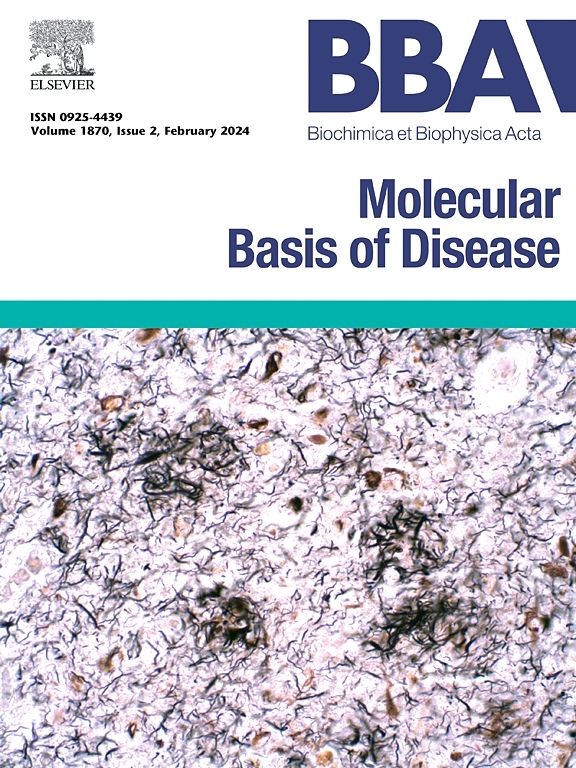线粒体经典代谢及其经常被低估的方面
IF 4.2
2区 生物学
Q2 BIOCHEMISTRY & MOLECULAR BIOLOGY
Biochimica et biophysica acta. Molecular basis of disease
Pub Date : 2025-04-10
DOI:10.1016/j.bbadis.2025.167839
引用次数: 0
摘要
几十年来,线粒体基本上被认为是维持真核细胞活力和功能所需的三磷酸腺苷(ATP)的主要提供者,因此被广泛流行为“细胞的动力源”。除了通过中间代谢产生ATP之外,这些胞内细胞器在生物合成中也具有显著的作用,作为生物合成中间体的产生体和/或作为生物合成的位点,尽管程度较低。从20世纪90年代开始,线粒体作为被动细胞器的概念,在按需的基础上为细胞的其余部分提供ATP和生物分子,否则它们就会被分离出来,这一概念受到了一系列范式转变的发现的挑战。也就是说,研究表明,线粒体作为信号效应物,在响应生长促进刺激时上调ATP的产生,并通过信号传导和表观遗传学积极参与大量细胞过程的调节,最终决定细胞的功能和命运。随着线粒体研究的重点越来越多地放在这些“非经典”功能上,线粒体中间代谢在其他线粒体功能中的中心地位往往被忽视。在本文中,我们重新审视线粒体中间代谢,并说明其中间产物,副产品和分子机制如何支撑其他线粒体功能。一定程度上强调了经常被忽视的线粒体功能,即铁硫(Fe-S)簇的生物合成,这是所有线粒体和线粒体相关细胞器共享的唯一已知功能。还详细讨论了活性氧(ROS)的产生及其在信号传导中的假定作用。本文章由计算机程序翻译,如有差异,请以英文原文为准。
Mitochondrial classic metabolism and its often-underappreciated facets
For many decades, mitochondria were essentially regarded as the main providers of the adenosine triphosphate (ATP) required to maintain the viability and function of eukaryotic cells, thus the widely popular metaphor “powerhouses of the cell”. Besides ATP generation – via intermediary metabolism – these intracellular organelles have also traditionally been known, albeit to a lesser degree, for their notable role in biosynthesis, both as generators of biosynthetic intermediates and/or as the sites of biosynthesis. From the 1990s onwards, the concept of mitochondria as passive organelles providing the rest of the cell, from which they were otherwise isolated, with ATP and biomolecules on an on-demand basis has been challenged by a series of paradigm-shifting discoveries. Namely, it was shown that mitochondria act as signaling effectors to upregulate ATP generation in response to growth-promoting stimuli and are actively engaged, through signaling and epigenetics, in the regulation of a plethora of cellular processes, ultimately deciding cell function and fate. With the focus of mitochondrial research increasingly placed in these “non-classical” functions, the centrality of mitochondrial intermediary metabolism to other mitochondrial functions tends to be overlooked. In this article, we revisit mitochondrial intermediary metabolism and illustrate how its intermediates, by-products and molecular machinery underpin other mitochondrial functions. A certain emphasis is given to frequently overlooked mitochondrial functions, namely the biosynthesis of iron–sulfur (Fe–S) clusters, the only known function shared by all mitochondria and mitochondrion-related organelles. The generation of reactive oxygen species (ROS) and their putative role in signaling is also discussed in detail.
求助全文
通过发布文献求助,成功后即可免费获取论文全文。
去求助
来源期刊
CiteScore
12.30
自引率
0.00%
发文量
218
审稿时长
32 days
期刊介绍:
BBA Molecular Basis of Disease addresses the biochemistry and molecular genetics of disease processes and models of human disease. This journal covers aspects of aging, cancer, metabolic-, neurological-, and immunological-based disease. Manuscripts focused on using animal models to elucidate biochemical and mechanistic insight in each of these conditions, are particularly encouraged. Manuscripts should emphasize the underlying mechanisms of disease pathways and provide novel contributions to the understanding and/or treatment of these disorders. Highly descriptive and method development submissions may be declined without full review. The submission of uninvited reviews to BBA - Molecular Basis of Disease is strongly discouraged, and any such uninvited review should be accompanied by a coverletter outlining the compelling reasons why the review should be considered.

 求助内容:
求助内容: 应助结果提醒方式:
应助结果提醒方式:


